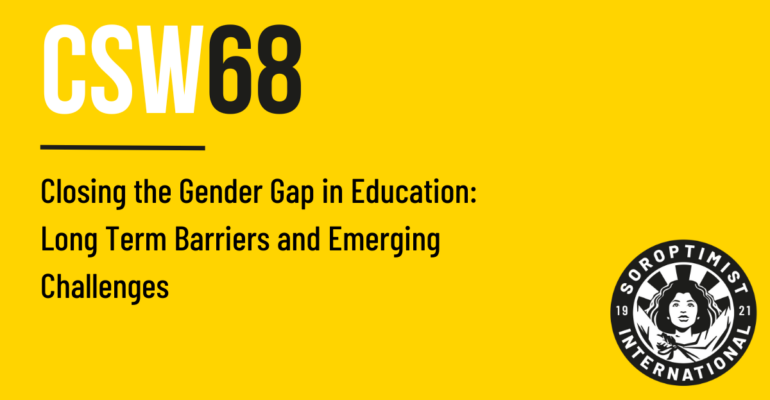The Office of the President of the General Assembly and UN Women presented an in-person event at CSW68 titled ‘Closing the Gender Gap in Education: How to Address Long-term Barriers and Emerging Challenges in a World of Complex Crises?
How can we make sure we are intersectional in closing the gender gap in education?
An interactive panel discussion ensued to address the key question of how can we ensure intersectionality in closing the gender gap in education? Various topics were covered including rights to justice, the situation of rural women, gender-based violence (GBV), right of education, right to live in a world free of violence, rights of indigenous women and girls, migrant women and girls.
Among these, the right to education was demarcated as essential in the Committee on the Elimination of Discrimination Against Women (CEDAW) considering women and girls for every State party to the CEDAW Convention. Access to education is a key issue in considering General Recommendations (GR) used to guide State Parties to the CEDAW Convention.
The presenters advocated for legislation and policies aimed at guaranteeing educational rights for women and girls across all levels, particularly for vulnerable groups like those with disabilities. They emphasized the need to eradicate discriminatory practices in education and highlighted the importance of setting the minimum age for marriage at 18 to combat child marriages.
There is a lack of information for women and girls with disabilities, we do not have enough data, even though we know that one in five women and girls in the world live with a disability. A high percentage of women and girls with disabilities are not in education; although segregation and special education takes place based on a medical approach, this is not on an equal basis for the rest of the population. Creating an inclusive population remains a challenge for many State Parties due to a lack of resources for accessibility.
However, creating an inclusive population is not a real solution because there is no consideration of gender in this approach. There is a pressing need to talk about women and girls with disabilities and this is why recommendations provided by the CEDAW Committee GR36 are fundamental for women and girls with disabilities. Until now, there are no good practices in place and these women and girls remain left behind.
Bridging the Digital Divide
The latest UNESCO monitoring report was discussed with the above key questions being raised. The latest report focused on technology in education, 2024 reports are now being finalised and will be published in April 2024. For women and girls, especially those living in crisis and countries experiencing conflict, technology and education can be a lifeline.
However, there are barriers in place including:
- Access – 130 million fewer women own a mobile phone compared to men, and similarly, there are 134 million fewer women online than men.
- Learning and acquisition of skills – across 50 countries, women were half as likely as men to be able to write a computer programme.
- Societal norms – negative impact of societal norms on women and girls use of technology is demonstrated by the fact that women may own smartphones but do not use the internet. In some cultures and families there is a disapproval of females using technology or there is insufficient income to access devices.
Several recommendations were made:
- Renewed focus on how digital technology can support the most marginalised women and girls.
- Adopt a multifaceted approach addressing these three barriers: access, usage and education in technology.
- Establish an assessment framework that is broad, not attached to specific moment in education.
There is an imperative to dismantle gender stereotypes and bias in science, showcasing women and girls as role models in Science and STEM-related subjects. Additionally, educational pathways must be opened for women and girls in science, with the inclusion of science in curriculums. Moreover, workplaces need to be created that not only attract but also retain women scientists, while simultaneously eliminating harassment and violence in the workplace.
Conclusion
In addressing the gender gap in education, the event ‘Closing the Gender Gap in Education’ highlighted the crucial importance of intersectionality in ensuring that no women or girls are left behind. The importance of legislation and polices for educational rights, particularly for vulnerable groups and those with disabilities, is recognisable through ongoing efforts to bridge the digital divide – although further efforts are required to enhance access to and education around digital technologies.

